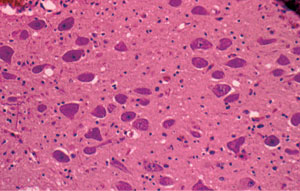






 |
 |

Chronic Wasting Disease in Mule Deer (Image 1)
Caption:
This slide shows tissue from the brain of a healthy mule deer. Note the absence of lesions caused by Chronic Wasting Disease. This image was taken as part of a research project on "Chronic Wasting Disease in Wildlife: Responses to Changing Land Use," conducted by researchers from Colorado State University. This research is supported by National Science Foundation grant DEB 00-91961. [Image 1 of 2 related images; see also, Chronic Wasting Disease in Mule Deer (Image 2).]
More about this Image:
Chronic wasting disease (CWD) of the deer family is a member of a group of infectious diseases caused by transmissible proteins called prions. Prion proteins accumulate in the brain of affected individuals, causing neural degeneration and inevitably, death. Similar diseases include scrapie in sheep and goats, bovine spongiform encephalopathy in cattle ("mad cow disease"), and Creutzfeldt-Jacob disease in humans.
The only place in the world where these diseases are known to occur in free-ranging wildlife is in northeastern Colorado and southeastern Wyoming, where an epidemic of CWD has been ongoing in populations of mule deer and elk for at least two decades.
In their National Science Foundation-supported research on "Chronic Wasting Disease in Wildlife: Responses to Changing Land Use," researchers from Colorado State University are studying the CWD epidemic to learn how it is transmitted and whether or not it can be transmitted from animal residues that accumulate in the environment (urine, feces, saliva, and carcasses). Principal investigator N. Thompson Hobbs and researchers Michael W. Miller and Elizabeth Williams will develop mathematical models to predict the spread of the disease as well as evaluate ways to contain it. The predictions of these models will be compared with field data on disease prevalence to identify the model that most reliably represents the behavior of the disease in mule deer populations. This model will be analyzed to understand how changes in land use resulting from rapid development are likely to affect the dynamics of the disease and to evaluate strategies for its management.
Chronic wasting disease poses a potentially major threat to members of the deer family throughout Western North America and although current evidence suggests that the transmission of CWD to people is unlikely, this possibility cannot be ruled out.

(Preview Only)

|
| Credit: |
Photo by Elizabeth Williams |
| Year of Image: |
2003 |
|
Categories:
BIOLOGICAL / Environmental
Formats Available:
TIFF Format - 3.58M - 772 x 1215 pixel image - 72 DPI
Sorry! This image is not available in a higher resolution.
Restrictions:
No additional restrictions--beyond NSF's general restrictions--have been placed on this image. For a list of general restrictions that apply to this and all images in the NSF Image Library, see the section "Conditions".
|